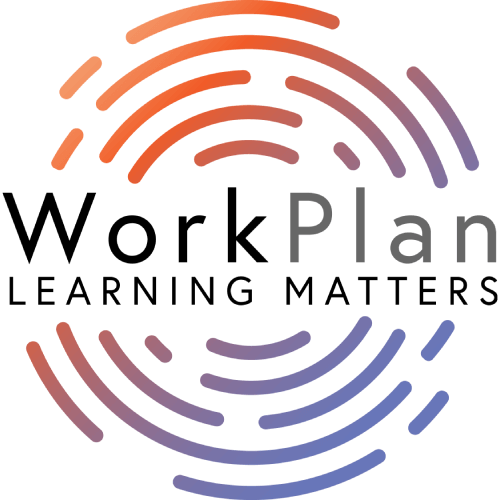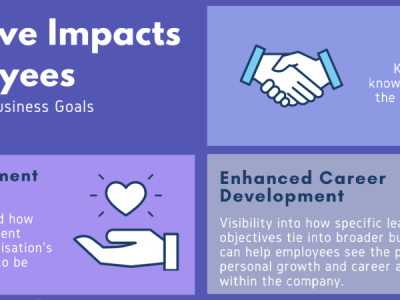WorkPlan shares 7 key reasons why aligning learning to your business strategy will benefit your staff and organisation.
Learning is a key pillar supporting the success and sustainability of any business. Here are seven compelling reasons why you should consider re-thinking how you deliver learning in your organisation if you are not currently aligning learning with a strategy.
1. People will better understand the purpose of their learning activities.
When people understand the purpose of the learning, they are better equipped to apply what they have learned to their work. A person undertaking training directly linked to a supporting goal or team objective, will apply thinking to the learning content that will help them apply it. Often the converse is true, a person undertakes a learning activity, only to have to figure out how to apply it. In this scenario, the chances of the person successfully retaining the knowledge or skill is greatly reduced.
2. People in your organisation will have a ‘line of sight’ between their personal and professional development and the purpose and strategy of the organisation.
This alignment helps them to engage more effectively with the organisation by supporting the feeling of contribution and engagement on a higher level. However, the opposite of this is all too common. A person simply shows up for work and undertakes whatever tasks they need to without having a sense of purpose. This scenario gradually degrades engagement with the organisation and the person is basically just showing up.
3. Learning helps people to engage more effectively with their manager when their development is aligned with team objectives.
A manager should be very invested in the development of his/her staff. Learning aligned with strategy is an ideal platform to provide reasons for more interaction. Itopens up paths to coaching and mentoring undertaken by the manager or another person. As a manager, reviewing learning activities undertaken staff managers is an ideal component of a performance appraisal process. It demonstrates a commitment to the development of the individual and helps to create a forward-looking discussion rather than one that is purely focused on past results.
4. Strategy is often perceived as being unclear and not something that people at mid and low levels in the organisation need to concern themselves with.
There are different levels of severity of this problem. In some cases, the leadership team may create a strategy, but it never gets communicated outside to the rest of the organisation. If it is communicated, it is often done once or possibly a few times but without a commitment to ensure understanding and retention. People in upper management may focus attention on the strategy, however those not directly impacted will not.
There are two solutions I advocate for this problem. One, as a leader you need to communicate the strategy so many times more than what you think is reasonable. You need to communicate it in different contexts as well so people can understand the scope and the purpose of the strategy. Second, the strategy needs to be cascaded at least down to team objectives to put it as close to the day to day work being performed as possible. This is why we designed WorkPlan Learning to include learning alignment with both strategic goals and team objectives.
5. Learning aligned with strategy builds future capacity and supports succession planning and extending people’s roles in the organisation.
With learning aligned with strategy, you will develop people with greater capacity to contribute to your organisation. Done correctly, aligning learning with your strategic goals will mitigate the risks of losing key people, through attrition, retirement etc. You will have people with the knowledge and skills to move into these roles with minimum disruption and time spent ramping them up.
6. Aligning learning and strategy ensures there is focus applied to learning activities
It helps avoid superfluous training that does not directly help develop the person or the organisation. When you are considering a learning activity or learning path for a person, team or across the organisation, you are better able to evaluate the merit and benefits from the training options available.
7. With strategy aligned to learning, the options for training can become much wider.
For example, peer to peer learning, whether informal or formal, is a powerful way to encourage skills and behaviour development in an organisation. Peer to peer learning is also very effective at improving culture by supporting stronger interpersonal relationships, shared purpose and interdependence. We included an easy-to-use content creator in WorkPlan Learning to encourage peer to peer learning.
We Have a Unique Strategy Program Designed to Help You
If you would like to explore how to align learning with your strategic goals, we have some options for you. We have a unique strategy program designed to help you undertake this process with whatever tools you currently have in your business. We will teach you a process and methodology for strategy development that you can apply in your business straight away.
ALSO READ: How You Can Implement Your Strategy Through WorkPlan Learning
Learn about WorkPlan Learning
You may be interested in exploring our collaborative learning management system, WorkPlan Learning. WorkPlan Learning is simple to use and delivers an easy way to align learning with your strategic goals and team objectives. You will also have access to meaningful analytics to ensure higher levels of engagement in your business.
Talk to our team today about accessing a demo
Related Articles
Are you ready to take your business to another level?
Contact us today
Head Office
1300 726 708
+61 7 3220 2229
Melbourne Office
+61 3 9752 5651
In the spirit of reconciliation WorkPlan acknowledges the Traditional Custodians of country throughout Australia and their connections to land, sea and community. We pay our respect to their Elders past and present and extend that respect to all Aboriginal and Torres Strait Islander peoples.



